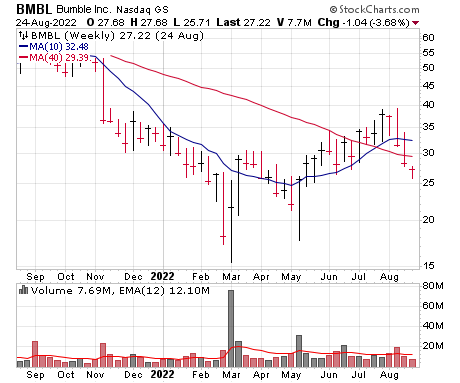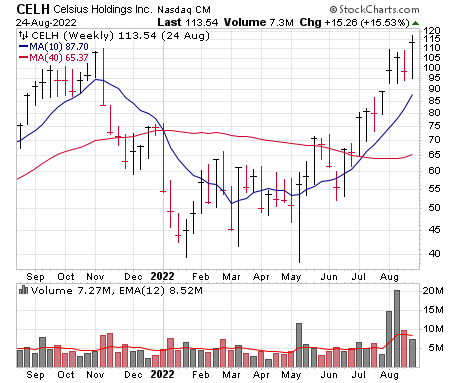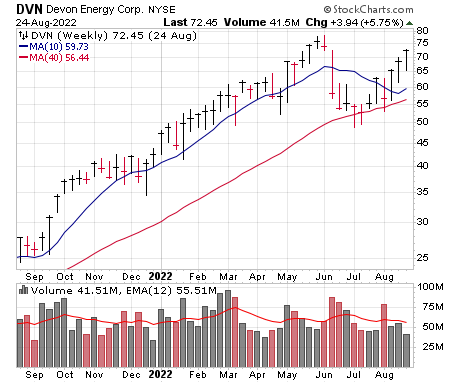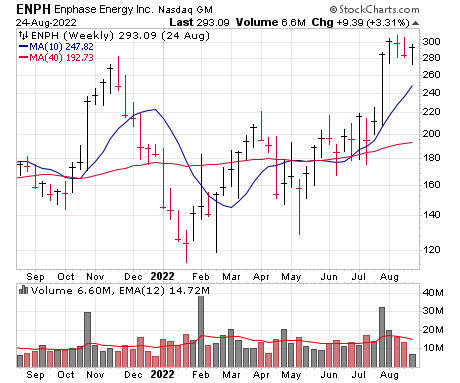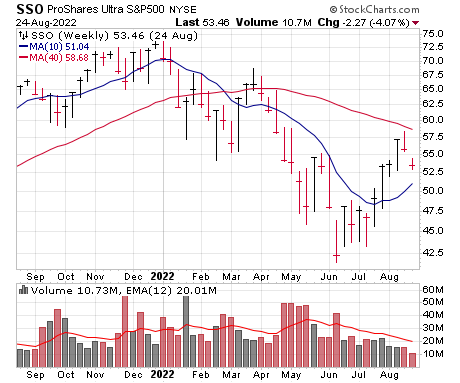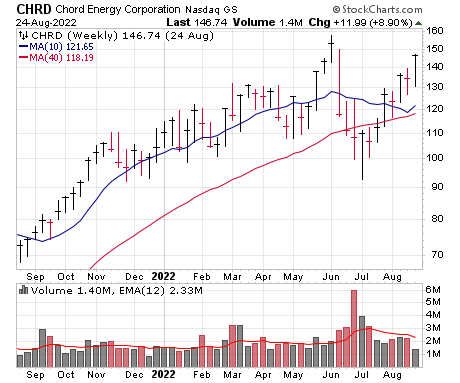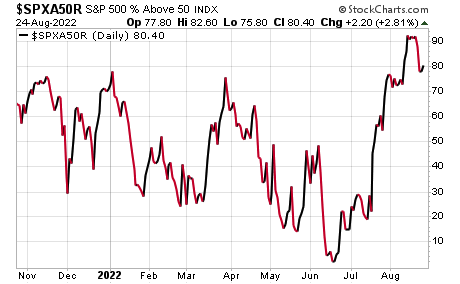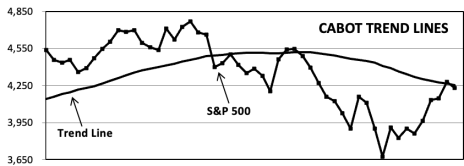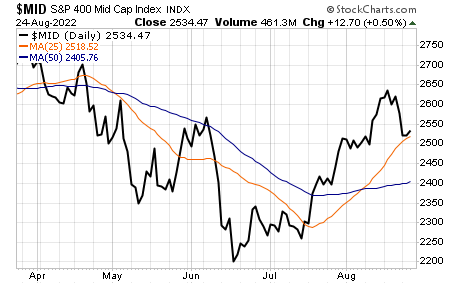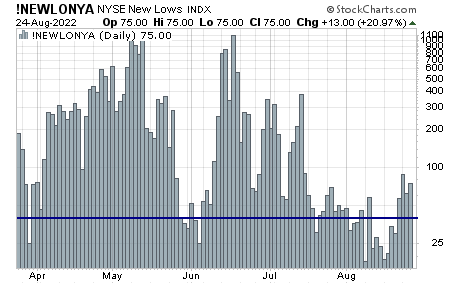Most people in the market (and in life) think of a lot of things as black and white, good or bad, bull or bear … and, frankly, for the market anyway, that’s often a good approach. We’re trend followers, after all, and we’ve designed our indicators to mostly be green or red, telling us whether stocks are headed up or down. It’s often best to play things in a decisive manner.
Cabot Growth Investor Issue: August 25, 2022
The In-Between
Most people in the market (and in life) think of a lot of things as black and white, good or bad, bull or bear … and, frankly, for the market anyway, that’s often a good approach. We’re trend followers, after all, and we’ve designed our indicators to mostly be green or red, telling us whether stocks are headed up or down. It’s often best to play things in a decisive manner.
But in reality, of course, there’s usually plenty of gray area, and that’s especially true when looking at big-picture market trends. For instance, it’s easy to pinpoint an exact market top in hindsight (the Nasdaq topped out on November 22, 2021), but in reality, we know that many glamour stocks topped out earlier that year (February 2021 was a top for many during the meme stock craze), with the summer and early fall seeing more and more names top out. In other words, the bull was ending far before the bear really kicked into gear.
Today, we think we could be in the opposite situation: That the bear market is effectively over, meaning the best stocks and likely the indexes have seen their nadir and some new leadership is forming as big, institutional investors dip some toes in the water—yet a fresh bull that results in a sustained advance with dozens of fresh leaders is still somewhere down the road.
It’s sort of an in-between situation, where there’s a decent amount of good, but there remain a few boxes unchecked concerning what’s normally seen when big investors change course and step on the accelerator. That’s the main reason we’ve been following our plan of leaning more bullish, but doing so slowly and selectively as we try to home in on some real leaders of the next move.
Speaking of leaders, though, that’s been the most encouraging thing we’ve seen since we sent out our last issue—while the major indexes have hit a pothole (and everyone is waiting for some inflation data and Fed guidance tomorrow), many potential leaders have pulled back normally, with a few ignoring the recent weakness altogether, bounding ahead to higher highs. Again, it’s definitely not a tidal wave of buying, but it certainly seems like the market is beginning to gravitate toward some growth-y themes that could drive things higher going ahead.
What to Do Now
As always, we advise staying flexible, taking what comes and focusing on what’s working. We did some re-jiggering last week, kicking out two under-performers (BMBL and HALO) and replacing them with one peppier name, Celsius (CELH), and adding more shares in our leveraged long index fund SSO), while also restoring our Buy rating on Devon (DVN)—and we’d like to do a little more buying given what we just wrote about some individual leaders. (We’re not having much trouble filling our watch list these days.) Tonight, though, we’ll stand pat as we wait for a bit more evidence that the recent market dip is just that, a dip, and not the start of a deeper retrenchment. Our cash position stands around 56%.
Model Portfolio Update
Given what we wrote on page 1—that the market could very likely be in some sort of an in-between phase—we’ve been going slow in the Model Portfolio and trying to start (and build) positions in what could be fresh market leaders should the rally gain power, while also still holding plenty of cash to give everything more rope if the sellers put up a fight.
That strategy has worked decently so far: While we did take a couple of body blows (HALO and BMBL) during earnings season, a few new additions have been doing well (we think we own two or three real leaders should the market move higher in the weeks ahead) and one old friend has started to reassert itself. And, despite the market’s recent dip, we’re actually seeing more intriguing names to potentially add to the Model Portfolio going forward.
However, we’re not going to ignore the overall market, which is still in decent shape, though the recent dip has put a few things back on the fence (new lows picking up again; our Aggression Index falling back, etc.). Tonight, then, we’ll stand pat, but as always, we’re ready to move in either direction—should the recent rally fall apart, we’ll pare back, though we continue to be more optimistic than not, especially with a gradual increase in the number of good-looking leading names.
Current Recommendations
| Stock | No. of Shares | Portfolio Weightings | Price Bought | Date Bought | Price on 8/25/22 | Profit | Rating |
| Bumble (BMBL) | - | - | - | - | - | - | Sold |
| Celsius (CELH) | 1,009 | 5% | 99 | 8/19/22 | 116 | 18% | Buy a Half |
| Devon Energy (DVN) | 2,413 | 8% | 28 | 6/4/21 | 74 | 162% | Buy |
| Enphase Energy (ENPH) | 680 | 10% | 291 | 8/3/22 | 295 | 1% | Buy |
| Halozyme (HALO) | - | - | - | - | - | - | Sold |
| ProShares Ultra S&P 500 (SSO) | 3,480 | 10% | 52 | 5/29/20 | 55 | 6% | Buy |
| Shockwave Medical (SWAV) | 807 | 12% | 245 | 7/22/20 | 310 | 27% | Buy |
| CASH | $1,117,790 | 56% |
Bumble (BMBL)—Bumble still has a lot of things going for it, including the growth for its namesake app, which remains very strong—it’s clearly taking market share from some bigger players like Match.com and Tinder. But that hasn’t been enough to overcome a horrid international performance and currency headwinds, with earnings dipping back into the red in Q2 and with management cutting its forecast for the rest of the year. The stock’s reaction to earnings wasn’t horrid initially, but BMBL has since cracked support, giving back most of the advance since its bottomed in May. We could see the stock eventually rounding into shape, so we’ll keep a distant eye on it, but we cut bait last week. SOLD
Celsius (CELH)—Celsius certainly has the look and feel of what we like to call rare merchandise—there simply aren’t that many firms sporting triple-digit sales and earnings growth, with a consumer story (i.e., it serves a true mass market and can be adopted rapidly) and a huge recent catalyst via its Pepsi tie-up. Indeed, distribution for the firm’s energy drinks is already expanding wildly (north of 80,000 locations at the end of June, about double that of a year ago; warehouse clubs are a big growth area, up about 15% sequentially thanks to 175 new BJs locations welcoming Celsius in Q2), but management said the Pepsi tie-up should boost its planned expansion by at least 40% during the next 12 months! We added a half-sized position in CELH last Friday, and the stock is certainly off to a good start, soaring off its 25-day line to hit new highs on big volume. We’re looking to fill out our position, though given the market’s recent wobbles and this stock’s massive volatility (it’s been moving around about seven points per day in recent weeks!), we’ll hold off right now. If you own some, just hang on and give the stock room to maneuver—if you’re not yet in, we’ll stay on Buy a Half, but we suggest aiming for dips of a few points. BUY A HALF
Devon Energy (DVN)—Since its second test of its 200-day line after earnings earlier this month, DVN has put on a fantastic show, rallying sharply and recouping more than three-quarters of its overall decline as energy stocks in general have come back into favor. One thing working in Devon’s favor is that its production profile is relatively balanced—in Q2, roughly half of output was oil, but one quarter was natural gas and the other quarter was gas liquids (all give or take), meaning oil is the bigger driver but Devon has plenty of exposure to gas, which recently touched $10, marking its highest level since 2008. Of course, oil has snuck higher as well (current prices are in the low $90s; December 2023 prices are low $80s), but we think an equally big part of the story is that Devon is still playing offense, using its cash flow to expand its reach, and at surprisingly good prices—the latest buyout (in the Eagle Ford) came at a whopping 30% free cash flow yield using strip prices, which the firm says should increase its variable dividend by up to 10% once it goes through. Back to the stock, the rebound (in DVN but also the group as a whole) is strong enough for us to restore a Buy rating, though we wouldn’t treat it as a pound-the-table situation—if you’re already in, we’d probably just sit tight, though for new buyers, we’re OK starting small here or (preferably) on dips. BUY
Enphase Energy (ENPH)—After failing to overcome the round-number resistance area of 300 earlier this month, ENPH was pulled down a bit by the market, but only a bit--like many leadership names, the damage has been limited with shares finding support near their 25-day line and with the again testing resistance today. (We’d also say a dip after the “good news” of the passage of the green energy bill is classic; the market likes to put the heat on late buyers with sell-the-news reactions.) The firm remains busy on the news front, but most of the releases tell us what we already know, that demand for its microinverters and energy storage solutions (and even EV chargers, a new product that should become much larger going forward) are rising quickly and more and more distributors are expanding their business with Enphase. All in all, we continue to think the stock quacks like a liquid leader, but we’re not taking anything for granted—should ENPH dip below 230 or so (the 50-day line is in the mid-230s and rising), it would likely coincide with a general market crack and likely cause us to pare back. Still, right now, we continue to think optimistically; if you own some, just sit tight and be patient, and if not, we think you can pick up some shares here or on further dips. BUY
Halozyme (HALO)—We punted on HALO last week when the stock’s bounce ran into immediate resistance and the stock revisited its post-earnings lows. And, moreover, the stock has clearly seen a change in character, with just a handful of up days during the past four weeks. Fundamentally, everything seems on track, but we wonder if there’s something lurking in the weeds (possibly worries over some prescription drug price controls that were in the green energy bill?) given the stock’s action. Either way, we’re looking for strength, and HALO clearly is acting more like an undervalued name that perked up during the bear phase than a real leader of the next sustained advance. SOLD
ProShares Ultra S&P 500 Fund (SSO)—Based on the improving evidence, we added a chunk to SSO last week and … that’s not off to a great start, with the major indexes obviously pulling in sharply starting last Friday. As we write later in this issue, the S&P 500 “mini” blastoff signal from a couple of weeks ago is a feather in the bulls’ cap, and combined with our still-bullish Cabot Tides, is a big reason we bought a bit more. That said, the blastoff is also a secondary measure, and some other things we look at (new lows, Aggression Index, etc.) have backed off. In other words, the market is in sort of the in-between we wrote about at the start of the issue—fine right here, but the next few days/couple of weeks will be telling. A drop back into the 50 to 51 area here would raise the prospects of another leg down in the market and could have us quickly pruning the shares we just added. Yet, right here, most of the evidence remains bullish, so we’ll stick to the plan; you can grab some SSO around here. BUY
Shockwave Medical (SWAV)—Anything is possible, but if the market can hold itself together and resume its nascent uptrend, SWAV certainly is in pole position to be one of the growth stock leaders—in fact, chart-wise, it’s one of the few growth titles this year that’s gapped to new highs on earnings and kept on running after, which is obviously a sign of big demand. Fundamentally, one of the big things here is that analysts are having a hard time keeping up with the growth—a few months back, analysts expected the company to make a modest profit this year, but now Wall Street is looking for $2.55 per share in 2022 and $3.51 in 2023, both of which will almost surely prove too low. (One analyst at a major brokerage firm has already bumped his guess for next year to $4.45.) Of course, there’s no question the stock is extended to the upside, so any further market indigestion could drag down shares, but there’s been no sign of that yet, with SWAV hitting a new high yesterday. Hold on if you’re in, and if not, you could start small here or ideally on a shakeout of 10 or 15 points. BUY
Watch List
- Albemarle (ALB 295): ALB has enjoyed a fantastic rebound since early July, testing new high ground after a huge Q2 report that saw lithium pricing come in well above expectations. Earnings are now expected to reach $20 per share this year (up five-fold from last year), and while 2023 has some questions, there’s little doubt the bottom line will remain elevated.
- CrowdStrike (CRWD 203): CRWD has been slowly repairing the damage for the past couple of months (lived above its 50-day line since the start of July) and looks poised to go higher—but earnings (due out August 30) will be key. A bullish gap up could be buyable.
- Gitlab (GTLB 65): GTLB pulled in a bit more sharply than we’d prefer to see, but the bounce off the 50-day line has been textbook thus far. The firm has the story and numbers to get moving, but like CrowdStrike, the upcoming earnings report (September 6) will probably tell us whether Gitlab is a new leader or not.
- Pure Storage (PSTG 31): PSTG remains in great shape, dipping a bit but quickly rebounding today. It, too, has an upcoming earnings report (August 31), the reaction to which will be telling.
- Wolfspeed (WOLF 121): WOLF gave up the ghost during the latter stages of the market’s spring downturn, but last week’s massive-volume earnings gap (and its gigantic chip story) puts it back on our watch list. See more later in this issue.
Other Stocks of Interest
Wolfspeed (WOLF 121)—There are often big shifts in the chip sector that produce new winners, and that’s likely happening again, as the current and coming boom in electric vehicle production (and a huge investment in charging infrastructure), not to mention the 5G expansion, should be the next growth drivers in the sector. But this shift is actually much bigger than that, and it involves what these new end products need: Specifically, chips that are far more efficient at the higher temperatures these power-hungry applications operate. The solution looks to be silicon carbide (SiC) technology, which has numerous advantages compared to regular silicon chips: They’re lighter, smaller and more efficient, boosting electric vehicle ranges by 5% to 10%, while for 5G base stations, these chips allow for twice as many users per tower and a 10-fold increase in data. Big clients (especially in the auto sector) are looking to secure supplies of SiC chips down the road, and Wolfspeed has the first-mover advantage on that front—in fact, it recently started testing production in a newly built facility that’s the first-ever fully automated fab for certain sized SiC chips; full production should start in six to 12 months—and because of that, clients have been beating a path to its door. Yes, current revenue growth has been solid (36%, 36%, 37% and 57% gains the past four quarters), but the real story lies in the firm’s so-called design-ins (clients are committing to using Wolfspeed’s chips in future offerings): A couple quarters ago, the company garnered $1.6 billion of design-ins, which itself was 60% larger than any prior quarterly figure—but just a couple of quarters later in Q2, Wolfspeed saw $2.6 billion in design-ins as clients rush to place their bets. Indeed, at an Analyst Day less than a year ago, the firm thought its revenues could grow to $2.1 billion by fiscal 2026 (ending June 2026), up from $746 million in the past 12 months, but now the top brass thinks that figure could be 30% or 40% larger as demand has come in larger than expected and Wolfspeed is winning a greater share of deals, too. To be fair, there is going to be SiC competition from many peers (Onsemi (ON) should be a big player), and Wolfspeed is clearly going to have to invest a lot of money to continue boosting capacity (one analyst thinks a share offering is possible down the road), but there’s little doubt the company is in pole position to be the leader in SiC technology, which should mean huge growth for a long time to come. WOLF still has work to do on the chart, but the recent action (likely eight weeks up in a row, including last week’s earnings move on the heaviest weekly volume in five years) tells us big investors are certainly becoming involved. WOLF is on our watch list.
Paylocity (PCTY 250)—I was on a Twitter space last week (basically a live podcast) and we were talking about some of our growth stock picking criteria, and one of the things I relayed was to look for the 3 Rs, with firms offering not just rapid growth, but also reliable growth, and ideally, with a long runway of growth as well—it’s the combination of all three that entices big investors to build big positions, which take time for them to build (and get out of). Paylocity is one of the leading human capital management (HCM) players, a long-term growth industry that still has a lot of expansion left, especially as the work environment has shifted since the pandemic—recruiting talent is a top priority for many firms while managing a remote or hybrid workforce has its own challenges, but Paylocity’s various software offerings (it claims to have the most modern and comprehensive suite, with demand picking up for recruiting and learning management) looking like the perfect fit. All of that is shown in the numbers: Sales growth has been ridiculously consistent (up between 28% and 37% each of the past five quarters), while earnings have been growing much faster (up 74% in Q2, the fastest growth rate in years) and underlying metrics looked great (33,300 clients, up 16% from a year ago; 92% revenue retention, highest level in years; average recurring revenue per client also up 16%, etc.). And most signs (and estimates) point toward another round of 30%-plus growth on the top line in the next 12 months. Shares have been in a long-term uptrend for years (albeit with plenty of dips and drops along the way), before finally going through the wringer during the past eight months, falling from 310 to 150 (round numbers). But PCTY began to repair the damage in June and July and then staged a great-looking gap on earnings three weeks ago. The pullback since then has been a bit tedious but totally normal in the context of things—it’s unlikely to be a rocket shot but we think PCTY has a chance to be a steady Eddie-type of winner should the market’s uptrend gain steam.
Chord Energy (CHRD 146)—We’re obviously pleased to see energy stocks perk up again—natural gas stocks look best, which isn’t a surprise given new highs in that commodity, but even oil-heavy names are rebounding. Devon remains our top pick and, really, has been the institutional leader of the group during the past year, but we’re keeping our eye on some “newer” names out there, usually formed when two smaller players combine. One is Chord Energy, which was created after Whiting and Oasis Petroleum completed a merger of equals a couple of months ago: The company has the largest acreage position in the Williston Basin (nearly one million acres) and the second largest output tally (to Continental Resources; 58% of output is oil, the rest gas and liquids), and the top brass believes the merger will result in huge synergies (north of 12% of the current market cap), which is helping to offset the inflation seen in drilling and production costs. And because it’s new and there are some moving parts following the merger, it looks like the cash flow potential here has been overlooked—at $90 oil and $6 gas (that latter figure is starting to look mighty low), pro-forma free cash flow should be north of $30 per share this year, and because debt here is so small (less than 0.2x cash flow), management is aiming to return 75% of that going forward. In practice, that means a great base dividend (3.5% yield) and plenty of additional payouts and share buybacks along the way (it gobbled up more than 2% of shares in July alone); all told, at current stock and energy prices, Chord could be returning 4% of the market cap per quarter, and there’s upside to those numbers in 2023 as old, money-losing hedges expire (Oasis alone saw $350 million of hedging losses in Q2!). As always, a true implosion in oil and gas prices would change perception, but it appears big investors are sniffing out huge payouts for a long time to come—indeed, CHRD (along with DVN) is within 10% of its all-time high, which is among the best in the sector. We do think near-term pullbacks are possible after the recent ramp (and the high-profile news about record natural gas prices), but should the recent commodity resurgence have legs, we think CHRD could be a new mid-cap leader.
What to Make of the S&P’s “Mini” Blastoff Green Light?
We’ve always been big fans of so-called blastoff indicators, which highlight rare instances when the market gets “hyper-overbought”—and they almost always lead to great gains in the major indexes, often without much weakness. Beyond the returns, if you line up the signals of the best blastoff indicators with the major indexes, you’ll see most come at major market inflection points, usually just a few weeks after the end of a bear phase.
We believe the reason they’ve tended to work so well is that they run against what most people believe or feel at the time—after months of poor market action, these massive shows of internal strength represent a sudden change in perception for the better, and that change in perception tends to have ripple effects for many months forward. The great technician Walter Deemer said it best: The market gets most oversold at the bottom, but most overbought at the beginning of a new advance.
The problem, though, is that everyone seems to have blastoff/thrust/momentum measures these days, and not all are really reliable—as a general rule, the easier the indicator is to trigger, and the more signals it’s triggered in the past three or four decades, the less meaningful it is. Even one of the more reliable measures flashed earlier this year during the March/April rally, but that obviously didn’t work.
To us, there are two salt-of-the-earth blastoff measures that, really, have never failed—the 2-to-1 Blastoff Indicator (the NYSE Advance-Decline Line averages 2-to-1 positive over a 10-day stretch), and the 90% Blastoff Indicator (90% of all NYSE stocks trade above their 50-day line at the close of any day; signal must come after a market correction of some sort). Both lead not just to above-average gains, but almost always to very little drawdown from the signal; the 90% indicator, for instance, on average sees the S&P lose a maximum of just 2%. We’ve followed these two for years and they’ve always steered us right ... but neither has flashed during this rally.
Then there are narrower, “mini” offshoots of these measures—some are mediocre at best, but one with a great record did speak up two weeks ago. Specifically, we saw 90% of S&P 500 stocks rise above their 50-day lines on Friday, August 12, and when combined with a couple of important qualifiers (it’s the first signal in at least six months; S&P 500 has been below its 200-day line sometime in the prior three months), it’s occurred 10 other times since 1990 (less than once every three years).
And it’s almost always been bullish: During the following six months, the S&P’s maximum gain was 13%, vs. a maximum loss of less than 2%, with bigger gains (23%) on average looking out 12 months (with the same small 2% max loss). The gains are even more dramatic when looking at the Nasdaq, with an average max gain of 37% looking out a year!
To be fair, of the 10 signals, there was one that led to a quick pullback (7% deep) before taking off, while another saw the market mostly do nothing (good or bad) during the next year. But none were true stinkers, and many were fantastic.
Getting back to the question in the title of this article—what do we make of this “mini” blastoff signal? For us, it’s basically a Trust but Verify situation: We’re treating it similarly as if some other secondary indicator (i.e., not the Tides or Trend Lines) turned positive, which means enough for us to take a little action, but we still want further confirmation the bulls are taking control.
Last point: Probably the biggest thing we are taking away from this study is simply this—not a single one of the S&P’s blastoff signals since 1990 (and, according to some studies we’ve seen, before then) came during major downturns, they always came after the bottom. Said another way, we’ve never seen a green light occur during any major correction or bear phase, at least during the past 32 years.
This sort of plays into our overall thesis that we touched upon at the start of today’s issue: While not definitive, especially with the longer-term trend of the market still pointed down, there are many factors that suggest the best stocks and most indexes have seen their worst level for the bear cycle. However, even if that’s the case, there are nearly as many factors that point toward the new bull market not quite being ready to run—that we’re in the midst of a bottom-building process with fits and starts as investors see what the Fed does and how earnings and the economy develop.
Obviously, we’ll change if the evidence does, but this viewpoint goes along with our approach of putting money to work in a selective, go-slow manner.
Cabot Market Timing Indicators
Since the last issue, the market has been up and down, but really nothing much has changed with the overall evidence—the trends remain mixed (intermediate-term up, long-term down) and the broad market, while OK, hasn’t truly seen the clouds part. We are seeing some peppier action among potential leaders, which is definitely encouraging, but overall we’re sticking with the go-slow game plan and staying flexible.
Cabot Trend Lines: Bearish
Our Cabot Trend Lines remain negative, but despite the recent dip, a decent rally from here could be interesting—currently the S&P 500 and Nasdaq are about 2% and 3% (respectively) below their 35-week moving averages, so a return of the bulls over the next couple of weeks could have a shot at flipping the longer-term trend. Of course, we never anticipate signals, and the still-bearish Trend Lines are a big reason we’re holding plenty of cash.
Cabot Tides: Bullish
The market’s latest dip hasn’t been pleasant, but our Cabot Tides are still solidly positive, with all the indexes we track—including the S&P 400 MidCap, shown here—well above their lower (50-day), rising moving averages, and to this point have “only” pulled in to their 25-day lines. We’re open to anything, of course, but just going with what we see, the intermediate-term uptrend that began in mid July remains healthy and intact.
Cabot Two-Second Indicator: Neutral
Our Two-Second Indicator technically flipped positive toward the end of last week, but the sellers haven’t quite left the building, with the number of NYSE new lows coming in above 40 four days in a row (though they appear to have shrunk back into the 20s today). All in all, we wouldn’t say the recent readings are super-definitive either way—they’re nothing compared to what we saw even in early July, but we’re still waiting for new lows to all but vanish (usually seen after major liftoffs).
The next Cabot Growth Investor issue will be published on September 8, 2022.
About the Analyst
Mike Cintolo
A growth stock and market timing expert, Michael Cintolo is Chief Analyst of Cabot Growth Investor and Cabot Top Ten Trader. Since joining Cabot in 1999, Mike has uncovered exceptional growth stocks and helped to create new tools and rules for buying and selling stocks. Perhaps most notable is his development of the proprietary trend-following market timing system, Cabot Tides, which has helped Cabot place among the top handful of market-timing newsletters numerous times.
